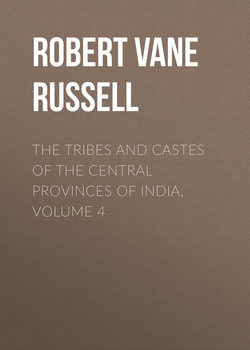Читать книгу The Tribes and Castes of the Central Provinces of India, Volume 4 - Robert Vane Russell - Страница 104
Part II
Articles on Castes and Tribes
Kumhār—Yemkala
Vol. IV
Lodhi
9. Social customs
ОглавлениеThe caste employ Brāhmans for weddings, but not necessarily for birth and death ceremonies. They eat flesh and fish, and the bulk of the caste eat fowls and drink liquor, but the landowning section abjures these practices. They will take food cooked with water from Brāhmans, and that cooked without water also from Rājpūts, Kāyasths and Sunārs. In Narsinghpur they also accept cooked food from such a low caste as Rājjahrs,99 probably because the Rājjhars are commonly employed by them as farmservants, and hence have been accustomed to carry their master’s food. A similar relation has been found to exist between the Panwār Rājpūts and their Gond farmservants. The higher class Lodhis make an inordinate show of hospitality at their weddings. The plates of the guests are piled up profusely with food, and these latter think it a point of honour never to refuse it or say enough. When melted butter is poured out into their cups the stream must never be broken as it passes from one guest to the other, or it is said that they will all get up and leave the feast. Apparently a lot of butter must be wasted on the ground. The higher clans seclude their women, and these when they go out must wear long clothes covering the head and reaching to the feet. The women are not allowed to wear ornaments of a cheaper metal than silver, except of course their glass bangles. The Mahālodhis will eat food cooked with water in the cook-room and carried to the fields, which the higher clans will not do. Their women wear the sāri drawn through the legs and knotted behind according to the Maratha fashion, but whenever they meet their husband’s elder brother or any other elder of the family they must undo the knot and let the cloth hang down round their legs as a mark of respect. They wear no breast-cloth. Girls are tattooed before adolescence with dots on the chin and forehead, and marks on one hand. Before she is tattooed the girl is given sweets to eat, and during the process the operator sings songs in order that her attention may be diverted and she may not feel the pain. After she has finished the operator mutters a charm to prevent evil spirits from troubling the girl and causing her pain.
99
The Rājjhars are a low caste of farmservants and labourers, probably an offshoot of the Bhar tribe.
